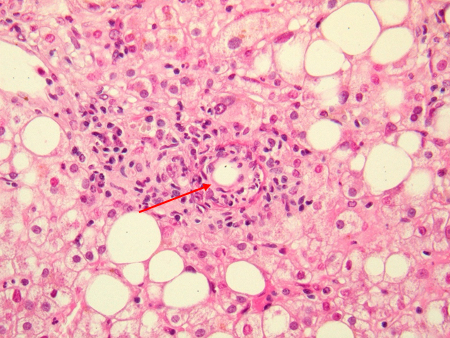Summary
Definition
History and exam
Key diagnostic factors
- რისკ-ფაქტორების არსებობა
- ძლიერი ცხელების სწრაფი გამოვლინება
- გრიპისმაგვარი ავადმყოფობა
- თავის ტკივილის მძიმე ფორმა.
- ხველა
- ჩასუნთქვისას ხიხინი, მსტვინავი სუნთქვა
- ჰეპატომეგალია.
Other diagnostic factors
- ეგზანთემები
- გულმკერდი პლევრიტული ტკივილიგულმკერდის პლევრიტული ტკივილი
- გულყრები
- კომა
- ქრონიკული დაღლილობა
- ენდოკარდიტის ან სისხლძარღვოვანი ინფექციის ნიშნები (პერსისტენტული ფოკალური ინფექცია)
- პერსისტენტული ფოკალური ინფექციის სხვა ნიშნები
- მწვავე ინფექციის სხვა ნიშნები
Risk factors
- ექსპოზიცია ინფიცირებულ ცხოველებთან
- პროფესიული ექსპოზიცია
- მოგზაურობა/ცხოვრება ენდემურ რეგიონში
- მამრობითი სქესი
- 30-70 წლის ასაკი
- იმუნოსუპრესია
- არსებული გულის დაავადება
- არსებული ვასკულოპათია
- ორსულობა
Diagnostic investigations
1st investigations to order
- არაპირდაპირი იმუნოფლუორესცენტული ანალიზი (IFA)
- პოლიმერაზული ჯაჭვური რეაქცია (PCR)
- FBC
- CRP
- LFT
- აქტივირებული ნაწილობრივი თრომბოპლასტინის დრო
- IgG ანტიკარდიოლიპინის (aCL) ანტისხეულები
Investigations to consider
- თავზურგტვინის სითხეში (CSF) უჯრედების რაოდენობა და დიფერენციული ანალიზი
- ცილა თავზურგტვინის სითხეში
- გლუკოზა თავზურგტვინის სითხეში
- გულმკერდის რენტგენოლოგიური კვლევით
- ტრანსთორაკალური ექოკარდიოგრაფია (TTE)
- ტრანსეზოფაგური ექოკარდიოგრაფია (TOE)
- ღვიძლის ულტრაბგერითი გამოკვლევა
- მუცლის ღრუს კომპიუტერული ტომოგრაფია ან ულტრაბგერა
- გულმკერდის CT (კომპიუტერული ტომოგრაფია)
- თავის ტვინის CT
- 18F-ფთორდეზოქსიგლუკოზით (FDG) PET/CT სკანირება
- ლიმფური კვანძების ბიოფსია
- იმუნოჰისტოქიმია
- ფლუორესცენტული ინ სიტუ ჰიბრიდიზაცია (FISH)
Treatment algorithm
მწვავე ინფექცია, არაორსული, მძიმე იმუნოდეფიციტის გარეშე: პერსისტენტული ფოკალური ინფექციის დაბალი რისკი
მწვავე ინფექცია, არაორსული, მძიმე იმუნოდეფიციტის გარეშე: პერსისტენტული ფოკალური ინფექციის მაღალი რისკი
მწვავე ინფექცია, არაორსული, მძიმე იმუნოდეფიციტით
მწვავე ინფექცია, ორსული
შესაძლო ან დადასტურებული პერსისტენტული ფოკალური ინფექცია, მძიმე იმუნოდეფიციტის გარეშე
შესაძლო ან დადასტურებული პერსისტენტული ფოკალური ინფექცია, მძიმე იმუნოდეფიციტით
Contributors
Authors
Stephen Gluckman, MD
Professor of Medicine
Medical Director, Penn Global Medicine
Hospital of the University of Pennsylvania
Penn International Medicine and Immunization Clinic; Penn Center for Primary Care
Philadelphia
PA
Disclosures
SG declares that he has no competing interests.
Acknowledgements
Professor Stephen Gluckman would like to gratefully acknowledge Dr Joshua Hartzell, Dr Matthieu Million, Professor Didier Raoult, and Dr Nilmarie Guzman, previous contributors to this topic.
Disclosures
MM and DR are authors of several references cited in this topic. JH and NG declare that they have no competing interests.
Peer reviewers
Jennifer McQuiston, DVM, MS, DACVPM
Epidemiology Team
Rickettsial Zoonoses Branch
National Center for Zoonotic Vectorborne and Enteric Diseases
Centers for Disease Control and Prevention
Atlanta
GA
Disclosures
JM declares that she has no competing interests.
Dimitrios Chatzidimitriou, MD, PhD
Clinical Microbiologist
National Influenza Center
Second Department of Microbiology
Aristotle University of Thessaloniki Medical School
Thessaloniki
Greece
Disclosures
DC declares that he has no competing interests.
Peer reviewer acknowledgements
BMJ Best Practice topics are updated on a rolling basis in line with developments in evidence and guidance. The peer reviewers listed here have reviewed the content at least once during the history of the topic.
Disclosures
Peer reviewer affiliations and disclosures pertain to the time of the review.
References
Key articles
Anderson A, Bijlmer H, Fournier PE, et al. Diagnosis and management of Q fever - United States, 2013: recommendations from CDC and the Q fever working group. MMWR Recomm Rep. 2013 Mar 29;62(RR-03):1-23.Full text Abstract
National Association of State Public Health Veterinarians, National Assembly of State Animal Health Officials. Prevention and control of coxiella burnetii infection among humans and animals: guidance for a coordinated public health and animal health response, 2013. 2013 [internet publication].Full text
Centers for Disease Control and Prevention. Q fever: information for healthcare providers. Jan 2019 [internet publication].Full text
Reference articles
A full list of sources referenced in this topic is available to users with access to all of BMJ Best Practice.

Differentials
- ლეგიონელას ინფექცია
- ტულარემია
- ვირუსული ჰეპატიტი
More DifferentialsGuidelines
- A guide to utilization of the microbiology laboratory for diagnosis of infectious diseases
- Health information for international travel: Q fever
More GuidelinesPatient information
Flu
More Patient informationLog in or subscribe to access all of BMJ Best Practice
Use of this content is subject to our disclaimer